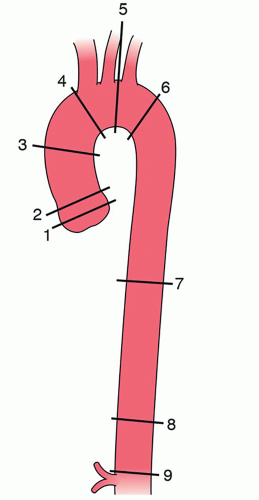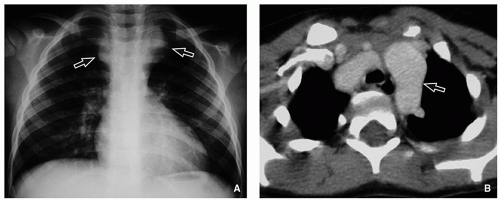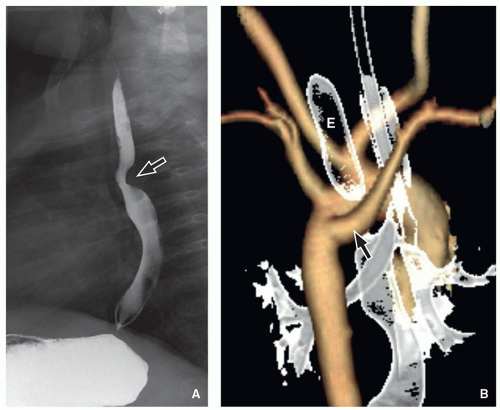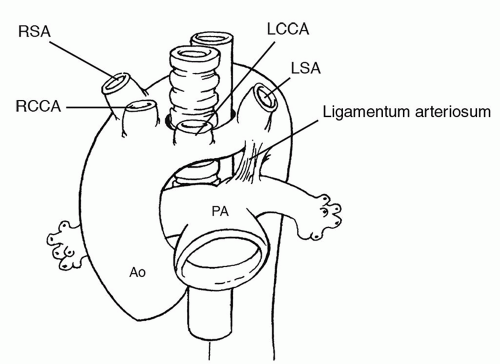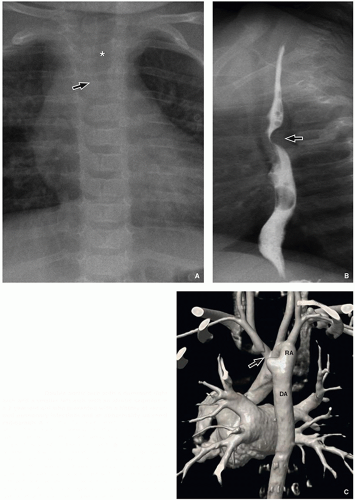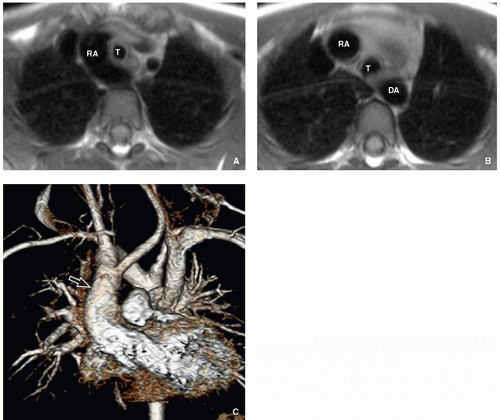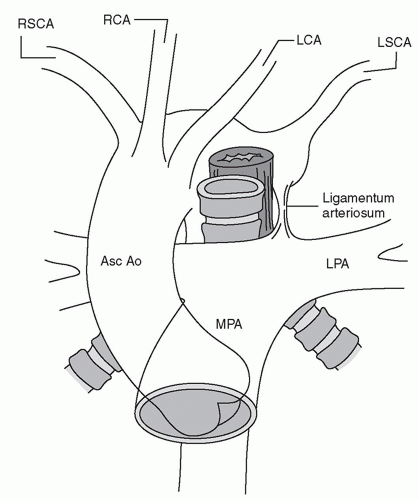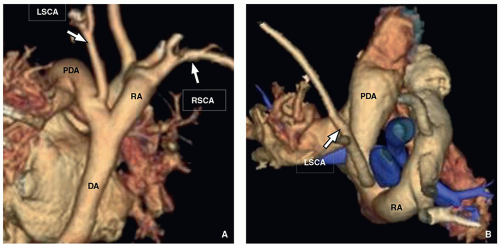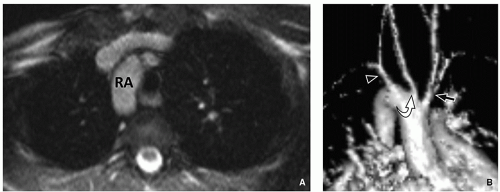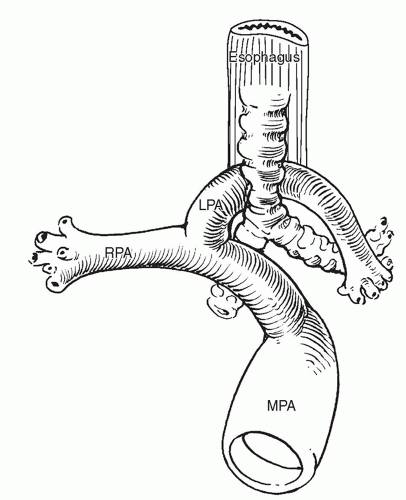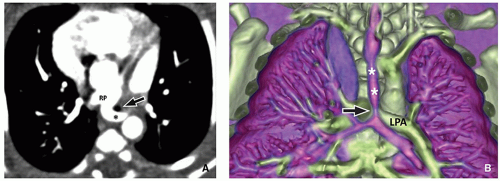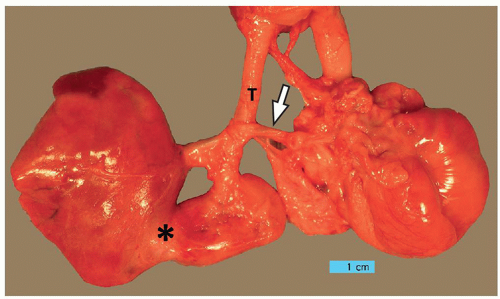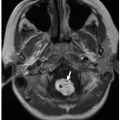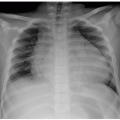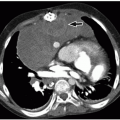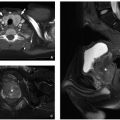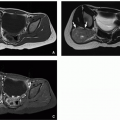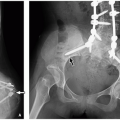Radiography
Chest radiography is readily available and provides a rapid and inexpensive means of obtaining initial diagnostic information in infants and children with clinically suspected thoracic vascular abnormalities. The chest radiograph provides valuable information concerning the structure and function of the cardiovascular system by permitting assessment of the size and extent of pulmonary vascularization as well as the size of the cardiac chambers. Although a chest radiograph is rarely sufficient to make a specific underlying cardiovascular diagnosis, for a small amount of radiation exposure (0.02 to 0.04 mSv), it may guide early treatment and subsequent advanced imaging and also serve as a baseline in certain conditions.
Chest radiographic examination usually consists of frontal and lateral views of the chest. In the case of neonates, chest radiographs are typically combined with an abdominal-pelvic radiograph, a so-called babygram, in order to facilitate the confirmation of appropriate positioning for all support devices including lines and tubes placed during initial evaluation. Subsequent chest radiographs should extend to at least the midabdomen, with or without the pelvis, depending upon the type of device, to account for variable degrees of inspiration. Such radiographs are obtained at the discretion of the medical team not only to permit the assessment of cardiovascular status but also especially to allow the evaluation of support devices, as malpositioned devices can lead to iatrogenic complications. In addition, the course of the support devices can offer clues to the individual patient’s underlying vascular
anatomy and provide a basis for the evaluation of congenital vascular abnormalities (
Table 10.1).
Ultrasound and Echocardiography
Ultrasound (US) and transthoracic echocardiography (ECHO) are usually the next diagnostic modalities employed in the assessment of infants and children with clinically suspected of having thoracic vascular abnormalities. Vascular US is used to visualize the peripheral vascular system, and ECHO is used for the heart, coronary arteries, pulmonary vasculature, thoracic aorta, and intrathoracic systemic veins. US and ECHO have advantages over other imaging modalities because they permit the noninvasive evaluation of morphology, function, and flow without exposure to radiation or potentially nephrotoxic contrast medium. Real-time gray-scale US images and cine loops are acquired in multiple projections to the heart, aorta, central pulmonary arteries and veins, and central intrathoracic systemic veins to depict various segments of the cardiac anatomy and vascular branches. In addition, flow characteristics such as direction and velocity can be determined by Doppler. However, US and ECHO are limited by acoustic impedance, operator skill, and ability to visualize peripheral vascular segments, including those of the pulmonary arteries, pulmonary veins, and supra-aortic branch arteries.
3,
4,
5
Computed Tomography
Nowadays, the evaluation of great vessel abnormalities can usually be performed with MDCT using CTA protocol without sedation and electrocardiographic gating. Because of the inherent radiation risk, CT should be judiciously used in pediatric patients. CT is typically indicated for evaluation of mediastinal vascular abnormality in infants and children when (1) there is a high sedation or general anesthesia risk; (2) coas-sessment of noncardiovascular structures, especially the airway and lungs, is required; (3) emergent imaging is necessary; and (4) higher spatial resolution is needed. Other advantages of CT include wide clinical availability and short examination times.
With the latest generation CT scanners, acquisition time <2 seconds is feasible for mediastinal vascular imaging in pediatric patients. On the other hand, a typical MRI examination is currently acquired over 30 to 45 minutes. Obtaining selected MRI sequences may potentially decrease the total examination time to 10 to 15 minutes, but in most instances, this does not entirely obviate the need for sedation or general anesthesia in infants and young children who cannot follow breathing instruction.
Thoughtful patient preparation before CT imaging can lead to high-quality CT data set for accurately assessing great vessels, which in turn can result in optimal patient care. In order to optimize photon delivery and minimize the adverse effect of noise, the targeted region needs to be isocentered in the gantry. All external metallic objects and support devices with metallic components (e.g., weighted feeding tubes) should be removed, if possible, from the region to be scanned. This is because the presence of radiodense material may result in streak artifacts and can aggravate the effects of noise when low-dose parameters are used.
4 Similarly, the upper extremities are raised above the head and out of the field of view when performing chest CT, whereas they are placed at the patient’s side for head and neck CT studies.
Because of their inherent dependence upon radiation, CT protocols in pediatric patients should strive for only one core series (i.e., a single-phase angiographic scan). Such CT examination is typically obtained using the lowest possible voltage (80 kVp is usually sufficient for most pediatric patients under 60 kg) and with weight-based low-dose milliamperage following as low as reasonably achievable (ALARA) principle. In addition, at lower tube voltages (80 kVp), the use of iodinated contrast material is more efficient and yields higher attenuation of the vascular structures scanned because 80 kVp is closer to the k-edge of iodine (33.2 keV).
7,
8For mediastinal vascular imaging with CTA, highly concentrated iodine contrast medium (300 to 370 mg I/mL) is administered according to weight (2 mL/kg, not to exceed 5 mL/kg or a total of 100 mL), at the highest weight-based injection rate possible via a pressure-limiting power injector (e.g., a pressure limit set to 200 to 250 psi).
3,
4,
5 The injection rate currently used varies according to the patient’s weight
and IV access. For example, the injection rate of ˜1.0 mL/s can be used in infants. For adult-sized older children, the contrast can be injected at 3 to 5 mL/s. The antecubital location is the preferred access site for the larger vein size needed to accommodate high flow rates of IV contrast administration for CTA. In neonates and young infants, a forearm, hand, or foot vein may also be considered. In such cases, the use of a power injectable, peripherally inserted central catheter is a more desirable and safer option.
4 On the basis of hemodynamic and anatomic data, the injection of IV contrast medium should be performed into the right upper extremity vein in order to limit streak artifacts from the dense contrast across the aortic arch, which can occur when the left upper extremity vein is used
9 (
Table 10.2). Initially, the test injection should be performed using peripheral IV access with saline with a flow rate similar to that planned for the contrast medium for CTA. If the test injection is uneventful, the contrast injection, followed by a saline chase to clear the venous inflow and optimize the volume of contrast medium that reaches the target region, can be subsequently obtained.
CT imaging using automated bolus tracking should be considered because this method permits the use of a lower total amount of contrast agent and optimizes the accurate timing of the CT scanning.
3,
10,
11 A region of interest (ROI) is placed in the vessel to be evaluated, and the CT imaging is triggered automatically when a predefined enhancement threshold (e.g., 90 to 150 HU) is achieved. In general, the minimum amount of coverage and the shortest possible scan times (fast gantry rotation times, high pitch, and volumetric CT techniques) should be used. If possible, coverage should be tailored to the specific clinical question, and radiosensitive organs such as the thyroid should be avoided or limited. CTA for the evaluation of mediastinal vascular abnormality is typically obtained under suspended respiration or during quiet breathing.
Once axial CT data set is obtained, they can be reconstructed into 3- or 5-mm-thick axial CT images for routine viewing and into at least 1.5 mm axial CT images with 50% overlap for reconstructions and to maximize 3D displays
3,
4,
5,
11 (
Table 10.3). The use of 3D visualization techniques provides comprehensive multiprojectional anatomical displays of often complex mediastinal vascular abnormalities for interactive interpretation, treatment planning, and postoperative and postendovascular evaluation.
1,
2,
3,
4,
5 Volume-rendered (VR) and maximum intensity projection (MIP) images are currently available and clinically helpful for (1) depiction of the spatial relationship between the vessels in question and the adjacent structures, (2) grading of vascular stenosis and extent, and (3) improved delivery of the findings obtained by imaging to the referring clinicians and families.
1 The use of interactive 3D workstations not only facilitates the evaluation of the vascular structures, which are better depicted in the z-axis, but also assists in overcoming the noise that may occur with the use of low-dose protocols.
4,
5,
6
Magnetic Resonance Imaging
MRI is an increasingly utilized imaging modality for evaluating the great vessels, particularly in the pediatric population. However, it is rarely used as a first-line imaging modality. MRI typically complements US or ECHO as a noninvasive alternative to conventional CA. When used to evaluate more central vascular structures such as great vessels, three main types of MRI techniques are currently available that include (1) ECG-gated “black-blood” MR imaging, (2) static and cine “white-blood” MR imaging, and (3) a 3D contrast-enhanced angiographic MR imaging.
Black-blood MR imaging refers to the low signal exhibited by cardiovascular structures. It is used primarily to delineate anatomy and morphology and to visualize spatial relationships, particularly those of vascular structures and the adjacent central airway.
5,
12,
13 In the past, spin-echo sequences were used for black-blood imaging; today, these techniques have been largely supplanted by fast spin-echo (FSE) and turbo spin-echo (TSE) techniques.
14 These MRI sequences are ECG gated at end diastole and may be obtained with or without double inversion recovery techniques in order to null the signal from blood. They also may be obtained in any desired plane, including the sagittal oblique or “candy cane” view. Care should be taken with slow-flowing blood and when gadolinium is present because these conditions may interfere
with the nulling of flowing blood and may appear bright on the sequence, potentially resulting in artifacts that may lead to misinterpretation. For this reason, gadolinium should be administered only after black-blood imaging has been performed.
14 T1-weighted gradient echo sequences performed before and after contrast administration are usually used instead of black-blood MR images for the assessment of vessel wall thickening in cases of vasculitis.
15Bright-blood or white-blood MR imaging may consist of static and/or cine images. Static white-blood images are generally obtained with the steady-state free precession (SSFP) technique; a full stack of the entire chest can be acquired in <30 seconds, providing a useful adjunct to the more time-consuming acquisition of a black-blood MR imaging sequence for anatomic depiction. Cine white-blood MR imaging is typically used to evaluate cardiac function and is usually obtained either with gradient-echo sequences or with a balanced-SSFP pulse sequence. These MRI sequences provide cine images that permit visualization of cardiac or valvular motion in multiple frames over the entire cardiac cycle, allowing assessment of cardiac function and calculation of ventricular volumes. The SSFP pulse sequence demonstrates high signal-to-noise and high contrast-to-noise ratios between the blood pool and myocardial interface.
11,
12,
13,
14,
16Angiographic techniques include time-of-flight MRA, multiphase (arterial and venous) 3D T1-weighted contrast-enhanced MRA, and time-resolved MRA. Contrast-enhanced acquisitions are often conducted in the coronal plane, depending on the required anatomical coverage and breath-hold duration. The use of time-resolved MRA permits the depiction of reliable first-pass imaging that is independent of the timing of contrast injection and acquisition, resulting in clear depiction of dextro and levo phases and providing insight into the hemodynamics of the disease process and the assessment of collateral circulation. Multiplanar reformatting, maximum-intensity projection, volume rendering, and virtual endoscopy are useful adjuncts for enhancing interpretation
5,
6,
12,
13,
16,
17,
18 (
Table 10.3).
Phase-contrast imaging with velocity-encoded imaging is a useful adjunct to the acquisition of angiographic MR images. It is primarily used as a noninvasive method to accurately quantify velocity, flow, and related pressure gradients. Pulmonary blood flow (Qp) and systemic blood flow (Qs) may be assessed with this technique and used to calculate the pulmonary-to-systemic flow ratio (Qp:Qs) and to determine the shunt fraction. A Qp:Qs >1.5 usually indicates a significant left-to-right shunt that may require intervention.
5,
19




